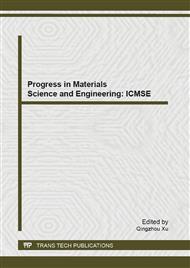p.273
p.279
p.287
p.293
p.299
p.305
p.312
p.317
p.321
Research on Proteinous Adhesive Made of Protein Isolated from Crayfish Shell Waste
Abstract:
Defatted crayfish shell waste (CSW) was prepared by the removal of extractable fat with cyclohexane. CSW was pretreated by benzoic acid and demineralized by acids. Proteins in the pretreated CSW were extracted with NaOH and 0-4% NaCl concentrations with 0.05% CaCl2 at pH 5.5-6.6 for 1 h at 50°C. By using the salt extraction procedure, CSW protein concentrate (29 g) was obtained from pretreated CSW (100 g). Recovery of protein was dependent on the extraction temperature employed; recovery values ranged from 33.2 to 51.4%. At 4% NaCl concentration, CaCl2 increased protein solubility by 30%, compared to the control. The adhesiveness of saltextractable protein at various pH values ranging from 5.0 to 9.0 was investigated. At pH 6.0-8.0, adhesiveness of salt-extractable protein showed the highest value (78.2 kg). The adhesiveness increased linearly as the salt-extractable protein concentration increased up to 24% with respect to temperature for salt-extractable protein adhesiveness, the greatest adhesiveness was in the range of 70 to 90. Improved adhesiveness and water resistance were observed with 0.05% glutaraldehyde treatment.
Info:
Periodical:
Pages:
299-304
Citation:
Online since:
October 2013
Authors:
Keywords:
Price:
Сopyright:
© 2013 Trans Tech Publications Ltd. All Rights Reserved
Share:
Citation:


